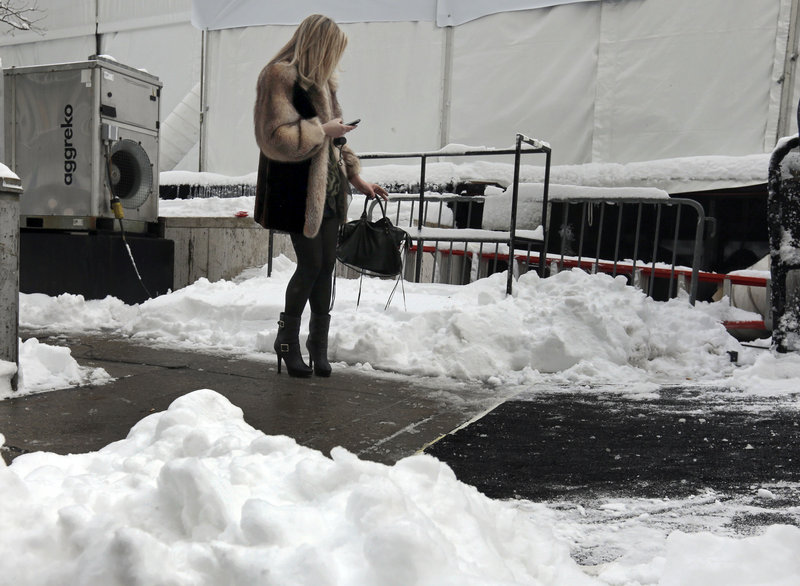HAMDEN, Conn. – The East Coast woke up under a blanket of snow this weekend and collectively documented the experience on the myriad social and mobile inventions of the past decade. Facebook, Twitter and other technologies make it increasingly difficult to stay isolated – even if you’re stuck home alone.
“The funny thing is that I actually checked my Instagram feed before I even looked out my own window,” said Eric Witz, who lives in Medford, Mass.
On Saturday, Witz posted a photo of his car buried under a “6-foot-high snowdrift.”
“I always have my phone on me. So checking these things is something I do instinctively when I wake up,” he said. “That probably makes me a sad social media clich?but it’s the truth.”
As northeasterners posted photo after photo of kids sledding in Central Park and suburbanites conquering Mt. Snowmore with their shovels, West Coast wags teased with tweets of sunshine and snapshots of palm trees.
Call it what you will: The Hashtag Snowstorm, the latest Snowpocalypse or Snowtorious B.I.G. The weekend whiteout was a lifetime away from the blizzard of 1978, a world not just without social media but one devoid of endless Weather Channel warnings and the lifeline of mobile phones.
Even the past two years have upended the way we receive information. We’ve moved from merely posting a status update with words to sharing photos and videos taken on smartphones, and we can’t let go.
Kathy Tracy was in junior high school when that famous snowstorm hit West Haven, Conn., 35 years ago, leaving as much as 27 inches of snow on the Northeast. She still lives there today, and some things haven’t changed. Snow is still snow, and people still wait for the streets to be cleared, hoping there is enough food and toilet paper to get by.
“The roads were so bad that my father and I took a sled and walked two miles to the grocery store,” Tracy said.
Getting updates of the ’78 blizzard meant turning on the radio or watching evening news programs. This weekend, Tracy said she turned to Twitter and nonstop news coverage to stay informed. She also follows a meteorologist on Facebook and receives updates from CNN, The Wall Street Journal and other news outlets.
While Tracy talked with a reporter on the telephone Sunday, she was still waiting for plow trucks to clear the 3 feet of snow the storm heaped on her neighborhood. But the information at the tips of her fingers made being stuck at home somewhat more tolerable.
“I guess what’s better is that you’re not sitting here waiting for the 6 o’clock news, waiting to find out what’s going on,” she said.
It’s easy to be nostalgic about how much things have changed since the blizzard of ’78 when it comes to the speed of information and how it’s consumed. But the changes continue.
“What really struck me this time around, and with (Superstorm) Sandy too, is not so much that people were sharing information, but that they were sharing photos and video,” said Steve Jones, a professor who studies online culture and communications at the University of Illinois at Chicago. “You get a different perspective than you could from just words.”
Indeed, said Ranvir Gujral, the co-founder of Chute, a San Francisco startup that helps companies put user-generated content on their websites and mobile apps, “we are in the midst of a visual revolution.”
Chute worked with NBC to launch Stormgrams, a site where people can share Instagram photos of the storm using a common hashtag, a way of marking posts to make them more easily searchable by topic.
The next task, something Gujral is hoping to do with Chute, is creating “ways to make sense of this cacophony of imagery.”
So what’s lost in this endless stream of snow-updates, Instagram photos and Facebook news? Serendipity, Jones said. Running into people and sharing a moment, offline, while events are unfolding.
And challenges remain.
“One thing we haven’t overcome is what you do if you don’t have electricity or if you are stranded in a car without a cellphone signal,” he said.
Copy the Story Link
Send questions/comments to the editors.



Success. Please wait for the page to reload. If the page does not reload within 5 seconds, please refresh the page.
Enter your email and password to access comments.
Hi, to comment on stories you must . This profile is in addition to your subscription and website login.
Already have a commenting profile? .
Invalid username/password.
Please check your email to confirm and complete your registration.
Only subscribers are eligible to post comments. Please subscribe or login first for digital access. Here’s why.
Use the form below to reset your password. When you've submitted your account email, we will send an email with a reset code.